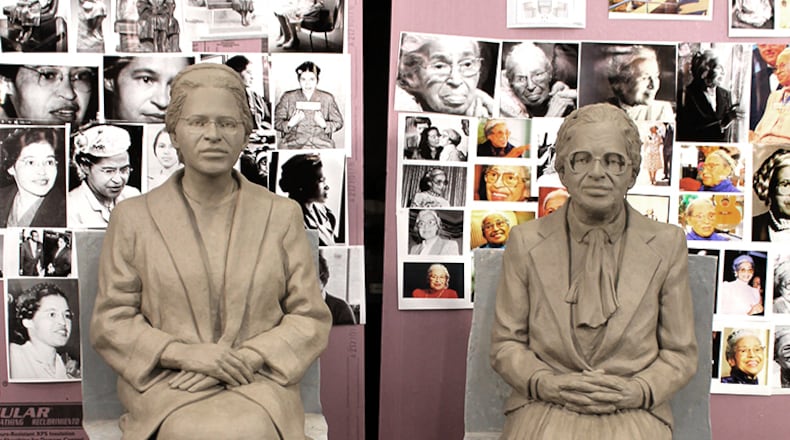As the 50th anniversary of the King assassination approaches, a quiet but bold woman whose actions catapulted him into the national spotlight will receive a rare honor for a female civil rights figure.
On April 5, the day after the nation observes the Rev. Martin Luther King Jr.’s death, an interactive installation depicting the later life of Rosa Parks will be unveiled at Georgia Tech. The bronze and granite work called “Continuing the Conversation” is a representation of the woman whose refusal to give up her seat on a segregated city bus in Montgomery, Ala., led to the seminal bus boycott that became an early victory in the Civil Rights Movement.
As rendered, the installation depicts Parks at 42 years old, when her actions launched the boycott, and at 92 years old, after her status as an icon had long been sealed. The younger Parks sits across from the older Parks with an empty seat between them, suggesting both women have wisdom to share with any visitor who wants to take the vacant seat.
Credit: Rob Felt
Credit: Rob Felt
A composition of bronze and granite, the idea for the $300,000 sculpture came from Martin Dawe, the Atlanta artist who created the bronze sculpture of King that now stands on the state Capitol grounds and was dedicated last year.
The Parks sculpture will sit in Harrison Square, the plaza at the heart of the campus named for Georgia Tech’s sixth president, Edwin D. Harrison. Harrison presided over the integration of the school in 1961, a move he made without a court order, which made Tech the first major university in the Deep South to integrate without a court mandate.
“We are honoring her, but we are also recognizing the whole civil rights movement,” said Georgia Tech Provost Rafael Bras.
Funds for the sculpture came from Tech alums Rod and Michelle Adkins, Bras said.
“This will speak to our young folks who lose contact with all that happened in the past to get us where we are today,” said Michelle Adkins.
Dawe, who is a member of the school’s external arts advisory committee, proposed the work after considering Parks died 50 years after making her stand against segregation. He wanted to reflect all the change that happened after the start of the boycott.
After funding was secured from the Adkins last November, Dawe and his crew set about sculpting the clay figures of Parks. By early this year, rubber casts were made of the two sculptures. Those molds were sent to a bronzing company in Utah for casting. The three granite benches, which weigh 2,000 pounds each, were quarried from Georgia granite in Elberton.
The new Parks statue is unique, because it is one of only a handful of sculptures around the country that portray historical female figures. According to the National Park Service website, of the 152 monuments, parks and buildings under the service's care, only three are dedicated to women, including one for a Harriet Tubman historic site in Maryland.
“It’s a signature piece for Tech and also a signature piece for Atlanta,” said Rod Adkins.
Dawe said depicting the aging process in Parks was fraught because both figures face each other and must look similar. But they must also show the effects of time on not just the face but the body. So, the older figure of Parks is a bit smaller than the one in middle-age. But on each version, her signature glasses remain.
“The main point is you sit between them,” Dawe said. “You’ll be the same distance between them as you would at a dining table. You could sit there for hours.”
Dawe said it’s not lost on him that he has created two major works of civil rights leaders in the last year. It’s a task he said he has been honored to take on.
“If I can use my talents for something that can affect change, it adds a lot more to what I’m able to do than just make clay models of people,” he said.
About the Author
The Latest
Featured





